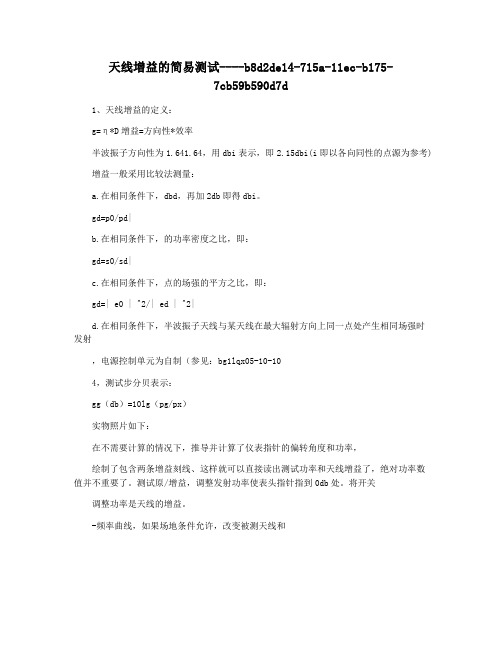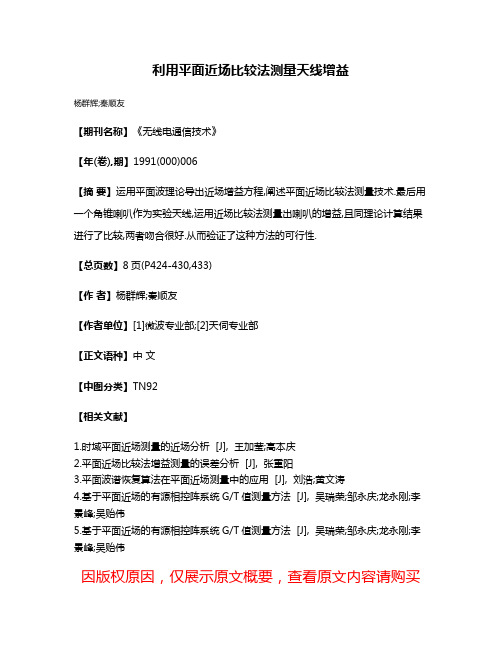近场天线增益测量方法的选择
电子科技大学课件《天线测量》第四章增益测量

第四章 增益测量第一节 引言天线的方向增益(通常称方向性系数)是表征天线所辐射的能量在空间分布情况的量,定义为在相同辐射功率情况下,该天线辐射强度),(ϕθp 与平均辐射强度之比,即0p 0),(),(p p D ϕθϕθ=(4﹒1) 由于辐射强度正比于电场强度的平方,因此,方向性系数也可写为 22),(),(E E D ϕθϕθ=(相同辐射功率) (4﹒2)式中,),(ϕθE 是该天线在),(ϕθ方向产生相同电场强度的条件下,点源天线的总辐射功率与该天线的总辐射功率之比,即 ),(),(0ϕθϕθT TP P D =(相同电场强度) (4﹒3)一般情况均指最大辐射方向的方向性系数,因此,式(4﹒1)、(4﹒2)、(4﹒3)可写为2020E Ep p D m m m == (相同辐射功率)mToTP P =(相同电场强度) (4﹒4) 方向性系数是以辐射功率为基点,没有考虑天线能量转换率。
为了更完整地描述天线的特性,我们以天线输入功率为基点,将该天线与点源天线作比较,于是,仿照方向性系数所定义的量就叫做天线的功率增益(通常称为增益系数),即22),(),(E E G ϕθϕθ= (相同输入功率) (4﹒5)或),(),(0ϕθϕθin inP P G =(相同电场强度) (4﹒6)式中,和in P 0),(ϕθin P 分别是点源天线和该天线的输入功率。
若指天线最大辐射方向的增益,则式(4﹒5)和(4﹒6)可写为 22E E G m m =(相同输入功率)inminP P 0=(相同电场强度) (4﹒7) 将式( 4﹒7)进行简单的换算,则有Am inm mTmT oT oT in inm oin m D P P P P P P P P G ηη••=•==00 (4﹒8) 式中,0η和A η分别是点源天线和某天线的效率。
令点源天线效率10=η,并因一般谈及方向性系数或增益系数均指最大发射方向,为简化书写,我们将足标“”去掉,于是式(4﹒8)就变为m D G A η= (4﹒9) 可见,天线的增益系数等于天线的效率与方向性系数之积。
天线增益的简易测试

天线增益的简易测试----b8d2de14-715a-11ec-b175-
7cb59b590d7d
1、天线增益的定义:
g=η*D增益=方向性*效率
半波振子方向性为1.641.64,用dbi表示,即2.15dbi(i即以各向同性的点源为参考)
增益一般采用比较法测量:
a.在相同条件下,dbd,再加2db即得dbi。
gd=p0/pd|
b.在相同条件下,的功率密度之比,即:
gd=s0/sd|
c.在相同条件下,点的场强的平方之比,即:
gd=| e0 | ^2/| ed | ^2|
d.在相同条件下,半波振子天线与某天线在最大辐射方向上同一点处产生相同场强时发射
,电源控制单元为自制(参见:bg1lqx05-10-10
4,测试步分贝表示:
gg(db)=10lg(pg/px)
实物照片如下:
在不需要计算的情况下,推导并计算了仪表指针的偏转角度和功率,
绘制了包含两条增益刻线、这样就可以直接读出测试功率和天线增益了,绝对功率数值并不重要了。
测试原/增益,调整发射功率使表头指针指到0db处。
将开关
调整功率是天线的增益。
-频率曲线,如果场地条件允许,改变被测天线和。
天线测试方法

天线测试方法天线是无线通信系统中不可或缺的组成部分,它的性能直接影响着通信质量和覆盖范围。
因此,对天线进行有效的测试是非常重要的。
本文将介绍一些常用的天线测试方法,希望能对大家有所帮助。
首先,我们来谈谈天线的VSWR测试。
VSWR(Voltage Standing Wave Ratio)即驻波比,是衡量天线匹配度的重要参数。
VSWR测试可以通过天线分析仪来实现,通过测量输入输出端口的反射系数,从而得到VSWR值。
通常情况下,VSWR值越小,说明天线的匹配度越好,性能也越稳定。
其次,天线增益测试也是非常重要的。
天线的增益直接影响信号的传输距离和覆盖范围。
增益测试可以通过天线测试仪器来实现,一般通过将天线放置在标准测试环境中,然后测量天线的辐射功率和参考天线的辐射功率,从而计算出天线的增益值。
另外,天线的方向图测试也是必不可少的。
方向图测试可以帮助我们了解天线辐射功率随方向的变化情况,这对于确定天线的辐射范围和覆盖方向非常重要。
通常情况下,方向图测试需要使用天线测试仪器,并在不同方向进行测量,最终得到天线的辐射功率分布图。
此外,天线的极化测试也是天线测试的重要内容之一。
天线的极化状态直接影响着信号的传输效果,因此需要对天线的极化特性进行测试。
极化测试可以通过天线测试仪器来实现,一般通过测量天线在不同极化状态下的辐射功率,从而得到天线的极化特性。
最后,我们还需要对天线的耐压和耐候性进行测试。
耐压测试主要是测试天线在额定工作电压下的性能,以及在异常情况下的耐压能力。
而耐候性测试则是测试天线在不同环境条件下的性能表现,例如高温、低温、潮湿等环境下的性能稳定性。
综上所述,天线测试是确保无线通信系统正常运行的重要环节,通过对天线的VSWR、增益、方向图、极化、耐压和耐候性等方面进行全面测试,可以有效地保证天线的性能稳定性和可靠性。
希望本文介绍的天线测试方法对大家有所帮助,也希望大家在实际工作中能够重视天线测试工作,确保通信系统的稳定运行。
各种近远场天线测量系统比较

按照天线场区的划分,天线测量系统可分为远场测量系统和近场测量系统。
1.远场测量系统远场测量系统按使用环境可分为室外远场测量系统和室内远场测量系统。
室外远场需要较长的测量距离,通常用天线高架法来尽量减小地面反射,其他架设方法还有地面反射法和斜距法。
室外远场测量需要在合适的外部环境和天气下进行,同时,室外远场对安全和电磁环境有较高要求。
室内远场在微波暗室中进行,暗室四周和上下铺设吸波材料来减小电磁反射。
如果暗室条件满足远场测量条件,可选择传统远场测量法,如果测量距离不够远场条件,可以选择紧缩场,通过反射天线在被测天线处形成平面电磁波。
2.近场测量系统近场测量在天线辐射近场区域实施。
在三至五个波长的辐射近场区,感应场能量已完全消退。
采集这一区域被测天线辐射的幅度和相位数据信息,通过严格的数学计算就可以推出被测天线测远场方向图。
按照扫描方式的不同,常用的近场测量系统可以分为平面近场系统、柱面近场系统和球面近场系统。
(1)近场测量系统平面近场测量系统在辐射近场区的平面上采集幅相信息,这种类型的测试系统适用于增益>15dBi的定向天线、阵列天线等,最大测量角度<± 70 º。
(2)柱面测量系统柱面近场测量系统在辐射近场区的柱面上采集幅相信息,这种类型的测试系统适用于扇形波束和宽波瓣的天线。
(3)球面测量系统球面近场测量系统在辐射近场区的球面上采集幅相信息,这种类型的测试系统适用于低增益的宽波瓣或全向天线。
3.如何选择天线测量系统,需要考虑到的几个重要的特性和指标:1.天线应用领域;2.远场角度范围:远场波瓣图坐标系、各种天线性能参数定义、副瓣和后瓣特性;3.电尺寸:根据电尺寸和计算出远场距离;4.方向性指标:宽波瓣或窄波瓣;5.工作频率和带宽:工作频率设计到吸波材料尺寸和暗室工程设计及造价;6.环境和安全性要求:天气、地表环境等因素;7.其他因素:转台或铰链、通道切换开关等。
天线增益测试方法

天线增益测试方法引言:天线增益是天线在特定方向上辐射或接收无线信号的能力。
在无线通信系统中,天线增益的测试是非常重要的,因为它直接影响到信号的传输和接收质量。
本文将介绍几种常用的天线增益测试方法。
一、理论计算法理论计算法是一种基于数学模型的天线增益测试方法。
它通过天线的物理特性参数以及信号传输的理论模型,计算出天线在特定方向上的增益值。
这种方法通常需要天线的几何参数、频率、天线材料等信息,并结合天线辐射方向图和功率密度图进行计算。
理论计算法具有较高的精度和准确性,但需要掌握天线理论知识和专业计算工具。
二、场强测试法场强测试法是一种实测天线增益的方法。
它通过在特定位置上设置场强测试仪器,测量天线接收到的信号强度,然后与参考天线进行对比,计算出天线的增益值。
场强测试法可以直接测量天线的实际性能,适用于各种类型的天线。
但需要在实际测试中考虑到环境因素对测试结果的影响。
三、标称增益测试法标称增益测试法是一种基于天线制造商提供的标称增益值进行测试的方法。
它通过查阅天线的规格书或制造商提供的技术资料,找到天线的标称增益值,并在实际使用中进行验证。
这种方法简单直接,适用于无法进行准确测量的情况。
但需要注意,标称增益值是制造商提供的理论值,实际性能可能会有一定差异。
四、比较测试法比较测试法是一种通过对比不同天线的性能进行测试的方法。
它通过选择一组具有不同增益的天线,在相同条件下进行测试,然后比较它们的信号强度,计算出增益值。
这种方法简单易行,适用于快速测试和筛选天线。
但需要注意选择合适的参考天线和测试环境,以保证测试结果的准确性。
五、模拟仿真法模拟仿真法是一种使用电磁场仿真软件进行天线增益测试的方法。
它通过在仿真软件中建立天线模型、设定工作频率和辐射方向,进行电磁场仿真计算,得出天线的增益值。
这种方法可以模拟不同工作条件下的天线性能,提前评估天线的性能。
但需要具备电磁场仿真软件的使用技能和较高的计算资源。
六、实测法实测法是一种直接在实际应用环境中进行天线增益测试的方法。
天线增益测量教学设计

天线增益测量教学设计教学设计: 天线增益测量一、教学目标:1. 理解天线增益的概念及其重要性;2. 掌握测量天线增益的方法和步骤;3. 能够根据测量结果评估天线性能的好坏。
二、教学内容:1. 天线增益概念和定义;2. 天线增益的测量方法和步骤;3. 天线增益的评估标准。
三、教学步骤:1. 导入部分(10分钟):a. 引入天线增益概念,解释其在通信系统中的作用;b. 提问学生:你认为如何测量天线增益?你希望通过测量天线增益能得到哪些信息?2. 理论讲解(30分钟):a. 分析天线增益的定义及其在通信领域中的应用;b. 介绍天线增益的测量方法:一是理论计算法,二是实测法;c. 解释天线增益的评估标准,如dB、dBi等。
3. 实验操作(40分钟):a. 设计实验装置:包括信号源、功率计、天线、介质等;b. 使用理论计算法进行测量:通过计算天线的射频功率Gt和接收功率Gr,应用增益定义公式计算天线增益;c. 使用实测法进行测量:通过在实验装置中加入用于接收和发射天线的移动终端,通过测量终端的接收功率和发射功率计算天线增益。
4. 数据处理(20分钟):a. 分析并比较理论计算法和实测法的测量结果;b. 讨论天线增益与其它因素(如频率、天线形状等)的关系;c. 利用测量结果评估天线的性能。
5. 总结归纳(10分钟):a. 总结天线增益的概念、测量方法和评估标准;b. 提问学生:什么因素会影响天线增益?如何进一步优化天线性能?四、教学资源:1. 实验装置(信号源、功率计、天线、介质等);2. 计算器、电脑等;3. 教师课件和实验指导书;4. 相关参考书籍和资料。
五、教学评估:1. 实验报告:要求学生填写实验记录和数据分析,以及对测量结果的评估和总结;2. 学生讨论:鼓励学生在实验结束后参与讨论、分享观点和经验;3. 教师评估:根据学生的实验操作和讨论表现,以及实验报告的综合评价,对学生的掌握程度进行评估。
六、教学延伸:1. 继续优化天线性能的方法和策略;2. 深入研究天线参数和增益的相关知识;3. 探究不同频率下天线增益的变化规律。
天线增益测量.

第一章概念1.1 定义1.1.1 功率增益天线在某方向上的辐射强度(每单位立体角内天线所辐射的功率)与天线从其信号源所得的净功率的比值称为天线在该方向的功率增益。
功率增益表征天线固有的性质,不包括因阻抗或极化失配所引起的系统损失。
在确定整个系统的功率传递时,要测量和考虑天线的输入阻抗与天线的极化。
1.1.2 峰值功率增益功率增益的最大值称为峰值功率增益。
本文所指的公路增益测量均为峰值功率增益测量,知道了辐射方向图就可确定任何其它方向的增益。
1.2 测量方法概述1.2.1功率增益测量方法分类功率增益测量方法可分为两大类:绝对法和比较法。
1.2.1.1 绝对法分类绝对增益测量不需要预先知道测量中所使用的任一天线的增益。
这种方法通常用于增益标准天线的定标。
除了专门从事标准定标的实验室外,其它实验室很少采用这种方法。
1.2.1.2 增益传递法增益传递发也称增益比较法,它是增益测量最常用的方法。
用这种方法进行测量时,需使被测天线的增益与增益标准的增益天线进行比较。
1.2.2 确定天线功率增益所采用的技术确定天线功率增益所采用的技术因天线的工作频率而异。
1.2.2.1 1GHz以上的频率在1GHz以上的频率,通常采用自由空间测试场进行功率增益测量。
对这些频率,可采用微波技术,例如可采用电磁喇叭等波导元件。
1.2.2.2 0.1‐‐1GHz之间的频率对于0.1‐‐1GHz之间的频率,通常用地面反射测试场进行测量。
在这一频率范围内工作的天线通常安装在诸如飞机之类的构件上,这些构件会影响天线的性能。
此时可采用比例模型技术。
然而,只要比例模型天线制作的合适,其方向性与原型天线的方向性是相同的,故可以测量比例模型天线的方向性,再用其它方法测出原型天线的效率,从而求得功率增益。
可使装有原型天线的飞机相对于一个适当的地面站按规定的路线飞行,以证实方向性测量结果。
可用原型被测天线测出系统性能,并与比例模型的测量结果进行比较。
9第9章 天线增益的测试

第9章天线增益的测试9.1 两天线法1.用途当有两个相同的小型天线要测增益时,可用此法。
尤其是圆极化天线,因为不容易找到标准增益天线作比较,不得不采用此法。
此法适于测试小的辐射中心明确的天线,如常见的手机天线、笔记本天线、瓷片GPS天线或单组贴片天线等等,不一而足。
2.原理此法的理论根据是,两点源在自由空间的插损IL是可以算出的,因此换成两个天线后,插损减小的dB值即两天线增益dB值的和。
若两天线相同,除2即得单个天线的增益dB值。
如其中有一个已知,也可算出另一个。
3.条件首先想法接近自由空间环境,在暗室中用吸波材料或在普通房间内采用小的测试距离以接近自由空间环境。
因此G≤10,频率高时好办些。
其次是被测天线应有明确的辐射中心,以便量距离。
如贴片天线的辐射中心就在口上,而八木天线的辐射中心就说不清,距离不好确定,严格来讲不适于此法。
4.算法对于天线口面每边D都≤λ的天线,测试距离R= 2D2/λ=2λ。
以GPS瓷片天线为例,λ=0.19 米,R=0.38m, 由(17-1)式知:两天线之间的衰减Pr /Pt= G1A2/4πR2 代入A2=G2λ2/4π=G1G2(λ/4πR)2代入R=2=0.00158G1G2以下用dB值表示,插损IL=G1dB+G2dB-28dB,即G1dB+G2dB=28dB-IL注意:两点源在自由空间的插损是(λ/4πR)2,而不是扩散因子1/(4πR2)。
5.测法·在两个相同的天线的背面直接装上插座,架好并保持口面间距为2λ;·两连接电缆校直通后,分别接到两个天线插座测其间插损IL;如IL=18dB,则G=5dB;注意:此法以点源为准,测出的增益倍数为G,dB数为dBi;此法可与比较法结合起来作,即可先测两个半波振子的G,以作比较。
9.2 三天线法当有三个天线时,可用此法。
条件同两天线法。
原理:用两天线法,可测得两个天线增益dB值之和;若有三个天线,其增益分别为G1,G 2,G3,两两组合测三次得:G1dB+ G2dB= XdBG2dB + G3dB= YdBG3dB+ G1dB = ZdB三式相加除2得 G1dB + G2dB + G3dB =(X+Y+Z)dB/2 = WdB 则:G1dB = WdB – YdB, G2dB = WdB – ZdB, G3dB = WdB - XdB三天线法显然比两天线法繁得多,不是极其考究的情况,不必采用。
22天线增益测量

实验二十二天线增益测量一、实验目的(一)、掌握天线增益的测量方法(二)、学会确定标准天线的方法二、实验内容1、用比较法测量天线的增益。
2、用三天线法测量标准天线的增益。
三、实验原理和方法各种天线都有一定的方向性,方向函数或方向图仅描述天线的辐射场强在空间的相对分布,为了定量描述天线在某一特定方向上的辐射能量的集中程度需引入天线方向系数这一参数。
绝大多数天线都需要通过实际测试来确定其增益,测量天线的增益有比较法和绝对法1、比较法图21-1示出了用比较法测量天线增益的测试系统方框图,其中图中的待测天线和标准天线作为发射天线。
如果与传输线匹配的待测天线和标准天线作为发射天线,比较法测量增益的实质是通过比较被测天线相对于标准天线的增益来测量待测天线的增益图21-1比较法测增益方框图⑴、把待测天线接入信号源,最大方向对准,调可变衰减器,使接受指示器有一个较大的指示值,记下精密可变衰减器分贝值Ax。
⑵、确定最小测试距离和架设高度⑶、进行电道估算选择测量仪器⑷、收发天线应架设在同一高度上,并将转台调到水平105106⑸、检查周围的反射电平及必须具备的测量条件 ⑹、转台转轴尽可能通过待测天线相位中心⑺、接上标准增益天线,最大方向对准,调整精密可变衰减器的值,使接受指示同刚才一样,记下衰减器的分贝值。
2、接待测天线,调衰减器使指示为一个值,记下待测天线输入功率假定1、阻抗匹配2、极化匹配3、最大方向对准4、距离相同 绝对增益的测量As x s AxP G G P =如果用精密可变衰减器测量功率()/1010()()()()x s A A x s x s x s G G G dB G dB A dB A dB -==+-2、双天线法(两天线相同)假设两天线极化和阻抗均匹配22()41420lg 10lg 2R A A R P P G rP r G dB r P λππ=⎡⎤⎛⎫⎛⎫=-⎢⎥⎪ ⎪⎝⎭⎝⎭⎣⎦由此可见,用两付相同增益的天线,只要测得收发天线之间的距离、工作波长及接收天线的接收功率与天线的输入功率之比即可确定天线的增益。
天线测试方法介绍

天线测试方法介绍天线测试是指对通信系统中的天线进行性能测试和验证,以确保天线能够正常工作并满足设计要求。
天线测试方法可以分为室内测试和室外测试两种。
一、室内测试方法:1.天线参数测试:包括天线增益、方向性、极化、带宽、驻波比、辐射功率等参数的测试。
可以使用天线测试仪器进行测量,如天线分析仪、信号发生器、功率计等设备,通过测量输出信号和接收信号的功率以及天线的辐射图案来评估天线的性能。
2.多路径衰落测试:通过模拟多径传输环境,测量天线在复杂信道环境中的性能。
可以使用信号发生器和功率计来模拟不同路径的信号,并通过天线接收到的信号来评估天线的接收性能和抗干扰能力。
3.天线阻抗匹配测试:通过测量天线输入端的阻抗参数,如阻抗匹配度、反射系数等来评估天线的阻抗匹配性能。
可以使用天线分析仪或网络分析仪等设备进行测量,通过调整天线的匹配电路来优化天线的阻抗匹配性能。
4.天线辐射图案测试:通过测量天线辐射图案来评估天线的方向性和覆盖范围。
可以使用天线测试仪器或天线测向仪等设备进行测量,通过调整天线的指向性来优化天线的覆盖范围和信号质量。
二、室外测试方法:1.参考信号接收强度测试:通过测量天线接收到的参考信号强度来评估天线的接收性能和覆盖范围。
可以使用功率计或天线测试仪器进行测量,通过调整天线的方向和位置来优化天线的接收性能。
2.通信质量测试:通过测量天线传输的数据质量、误码率等指标来评估天线的传输性能。
可以使用通信测试仪器和信号发生器进行测量,通过调整天线的参数来优化天线的传输性能。
3.电磁兼容性测试:通过测量天线的电磁辐射和电磁敏感度来评估天线的抗干扰能力和电磁兼容性。
可以使用电磁辐射测试仪器和电磁兼容性测试设备进行测量,通过调整天线的设计和布局来优化天线的抗干扰能力。
总结:天线测试是确保通信系统中天线正常工作和满足设计要求的重要环节。
通过室内测试和室外测试方法,可以评估天线的性能、阻抗匹配性能、多路径衰落性能、辐射图案等指标,优化天线的设计和布局,提高通信系统的性能和可靠性。
利用平面近场比较法测量天线增益

利用平面近场比较法测量天线增益
杨群辉;秦顺友
【期刊名称】《无线电通信技术》
【年(卷),期】1991(000)006
【摘要】运用平面波理论导出近场增益方程,阐述平面近场比较法测量技术.最后用一个角锥喇叭作为实验天线,运用近场比较法测量出喇叭的增益,且同理论计算结果进行了比较,两者吻合很好.从而验证了这种方法的可行性.
【总页数】8页(P424-430,433)
【作者】杨群辉;秦顺友
【作者单位】[1]微波专业部;[2]天伺专业部
【正文语种】中文
【中图分类】TN92
【相关文献】
1.时域平面近场测量的近场分析 [J], 王加莹;高本庆
2.平面近场比较法增益测量的误差分析 [J], 张重阳
3.平面波谱恢复算法在平面近场测量中的应用 [J], 刘浩;黄文涛
4.基于平面近场的有源相控阵系统G/T值测量方法 [J], 吴瑞荣;邹永庆;龙永刚;李景峰;吴贻伟
5.基于平面近场的有源相控阵系统G/T值测量方法 [J], 吴瑞荣;邹永庆;龙永刚;李景峰;吴贻伟
因版权原因,仅展示原文概要,查看原文内容请购买。
天线测试方法介绍

天线测试方法介绍天线测试是指对无线通信设备或系统中的天线进行性能测试和验证的一系列技术手段和方法。
天线的测试旨在评估其工作频段、增益、辐射图案、回波损耗、驻波比以及其他性能参数,确保其符合设计要求并满足通信系统的性能需求。
本文将介绍天线测试的方法。
一、测试设备的选择和准备在进行天线测试之前,需要准备一些测试设备。
主要有天线测试仪、信号源、功率计、频谱分析仪等。
这些设备的选择应根据实际测试需求来确定,并确保其性能和精度符合测试要求。
二、天线增益测试天线增益是反映天线辐射能力的重要指标,对于天线的调试和优化非常关键。
天线增益测试的方法主要有场强法、功率比法和功率流量法。
场强法是通过测量接收信号的场强和发送信号的功率来计算天线增益;功率比法是通过测量发射信号和接收信号之间的功率差异来计算天线增益;功率流量法是通过测量发射信号在一定距离内的功率衰减来计算天线增益。
不同的测试方法适用于不同的测试场景,需要根据具体的测试需求来选择。
三、天线辐射图案测试天线辐射图案描述了天线在空间中的辐射特性,是评估其指向性和可用方向性的重要指标。
天线辐射图案测试的方法主要有自由空间测试法、全视场测试法和屏蔽室测试法。
自由空间测试法是将天线放置于开放空地上,通过测量发射信号的功率和方向来绘制天线辐射图案;全视场测试法是将天线置于旋转平台上,通过旋转平台的控制来改变天线的方向,从而测量不同方向的辐射特性;屏蔽室测试法是将天线置于屏蔽室内,通过测量不同方向上的电场强度来计算辐射特性。
不同的测试方法适用于不同的测试场景,需要根据具体的测试需求来选择。
四、天线回波损耗测试天线回波损耗是指天线发送信号时,部分信号由于反射和散射在天线端口反射回来的损耗。
回波损耗测试主要通过测量功率差异或反射系数来评估。
测试方法有反射系数法、两端法和西口法等。
反射系数法是通过测量天线端口上的发射信号和反射信号的功率差异来计算回波损耗;两端法是通过在天线之间设置一个匹配器,测量匹配器端口上的发射功率和反射功率来计算回波损耗;西口法是通过在天线输出端口设置一个西口来测量反射信号的功率来计算回波损耗。
天线 近远场 测量方法

天线近远场测量方法Measuring the near and far field of an antenna is crucial for understanding its performance and ensuring accurate communication. The near field refers to the region close to the antenna where the electromagnetic fields are not yet fully developed, while the far field is the region further away where the fields are fully established. By carefully measuring both fields, engineers can optimize the antenna design and placement for maximum efficiency and reliability.测量天线的近场和远场对于了解其性能并确保准确通信至关重要。
近场指的是靠近天线的区域,电磁场还没有完全发展,而远场是指更远处的电磁场完全建立的区域。
通过仔细测量这两个场,工程师可以优化天线设计和放置,以实现最大的效率和可靠性。
One common method for measuring the near field of an antenna is the use of a near-field scanner. This device moves a probe close to the antenna to capture the electromagnetic fields emitted. By analyzing the data collected, engineers can construct a detailed mapof the near-field pattern, helping them identify any anomalies or interference that may affect the antenna's performance.测量天线的近场的一种常见方法是使用近场扫描仪。
天线近场测量方法

天线近场测量方法
天线参数的测量有助于我们了解天线性能,并对其加以更合理的应用。
一、近场测量的基本方法
目前在天线近场测量领域,常用的天线测量方法有平面扫描、柱面扫描和球面扫描,这些方法分别需要在平面、柱面、球面上采集数据。
二、近场测量方法的特点
平面近场扫描需要较小的暗室环境、较简单的调整技术和数学分析。
这项技术适用于高定向性天线测量,如蝶形或者相控阵等,几乎所有接收或发射的能量都穿过平面扫描区域。
但平面近场只覆盖待测天线方向图的有限区域,因此很难测定天线的方向性。
柱面近场扫描适用于扇形波束天线测量,其能量较为集中于一轴,而在另一正交轴上较为分散,如手机基站天线,其辐射方向图大部分局限于俯仰向的小范围内。
球面近场扫描能用于任何天线的测量,尤其适用于那些不适合平面和柱面测量的全向或近似全向天线。
该方法不存在测量面的截断,因此可用于精确测定任意类型的天线的远副瓣。
(资料来源于IEEE天线近场测量标准)。
应用微波功率计测量的天线功率增益

应用微波功率计测量的天线功率增益天线功率增益是衡量天线性能的重要指标之一,它描述了天线在特定方向上与理想天线(等效于点源辐射)相比,在接收或发射电磁波时的增益效果。
应用微波功率计测量天线功率增益可以帮助我们了解天线的性能特点,并为天线设计和应用提供准确的数据支撑。
微波功率计是一种用于测量高频电磁场的仪器设备,可以测量天线输入或输出功率。
在应用微波功率计进行天线功率增益测量时,需要注意以下几个关键步骤。
首先,正确选择合适的微波功率计。
微波功率计的频率范围、功率范围和精度等参数需满足实际需要,以确保测量结果的准确性。
同时,根据天线的工作频率选择合适的探头,以保证信号的正确采集和测量。
其次,进行标定和校准。
在进行天线功率增益测量之前,需要进行功率计的标定和校准。
对于微波功率计,标定常用的方法有负载标定和参考功率标定。
负载标定可以用于校准功率计的零度位置和灵敏度,参考功率标定能够获得准确的功率参考值。
标定和校准的目的是消除误差,确保测量结果的可靠性和准确性。
接下来,在实际测量中,需要准备好测试环境。
除了选择适当的测试场地和设备外,还需注意消除或降低其他电磁干扰源。
确保测量环境干净、稳定,并尽量减小不确定度。
在进行天线功率增益测量时,可以采用不同的方法。
其中,最常用的方法是全向发射源法和局部反射源法。
全向发射源法是通过将天线放置在一个全向辐射源(如一个无线发射器)的辐射范围内,测量天线输入功率和接受到的信号功率,从而得到天线的功率增益。
该方法适用于天线的工作频率较高,辐射源较易获得的情况。
局部反射源法则是通过在天线附近放置一个人工反射源,测量其反射功率和天线输入功率,从而计算天线的功率增益。
该方法适用于天线工作频率较低,无法直接获得全向辐射源的情况。
无论使用哪种方法,在测量过程中需要注意信号的校准和稳定性。
同时,还要确保天线和微波功率计的连接和放置正确无误,以免产生额外的误差。
测量完成后,应对数据进行处理和分析。
天线增益测量

发射天线接入端
216MHz
470MHz
5.1dBm
5.7dBm
700MHz 6.1dBm
测试位置要求
序号 1 2 3 4 5 6
名称 发射天线高度 测试天线高度 两标准天线距离(端口)
支撑架距离 标准接收天线端与支撑架距离 吸波材料边缘与支撑架距离
参数要求 1.5米 1.5米 3米 5.3米 0.95米 1.4米
Pr-接收天线输出功率 PinT-发射天线输入功率
1、接好天线,并将收、发天线最大辐射方向对准 2、记录发射天线的输入功率PinT及接收天线的输出功率Pr 3、根据公式计算天线增益
三天线法
公司的增益测试方法〔两相同天线法〕
各点的功率要求
放大器前输出 -22.5±0.7dBm
174MHz 5.0dBm
本卷须知: 1、收、发天线距离必须满足远场条件 2、尽量防止周围物体的影响 3、收、发天线与设备必须有良好的阻抗匹配,收、发天线之间也要有良好的极化匹配 4、当待测天线与标准天线增益相差较大时〔即孔径相差较大〕,换接天线时应使它们 的相位中心在同一位置上 5、为了防止外来干扰信号,信号源可加调制,接收端可用测试接收机等记录设备
不是,只是方向性系数,必须考虑天线能量转换
如何提高增益?
从无用方向挖掘,增大有用方向的能量辐射
天线增益测量方法: 比较法 两相同天线法 三天线法
比较法测天线增益
比较法实质就是用一个增益的天线作为标准天 线,通过与标准天线的进行比较得到待测天线的增 益。待测天线可作为发射天线,也可作为接收天线。
1、将辅助天线接入发射天线端 2、将标准天线对准辅助天线,使指示器读数最大 3、调节可变衰减器,使指示器指示某一个值A,记下此时可变衰减器的数值N1 4、将待测天线代替标准天线,对准辅助天线,使指示器读数最大 5、调节可变衰减器,使指示器保持数值A,记下此时可变衰减器的数值N2 6、天线增益G=Gs+N1-N2〔dB) Gs为标准天线增益值
天线增益测量的流程

天线增益测量的流程下载温馨提示:该文档是我店铺精心编制而成,希望大家下载以后,能够帮助大家解决实际的问题。
文档下载后可定制随意修改,请根据实际需要进行相应的调整和使用,谢谢!并且,本店铺为大家提供各种各样类型的实用资料,如教育随笔、日记赏析、句子摘抄、古诗大全、经典美文、话题作文、工作总结、词语解析、文案摘录、其他资料等等,如想了解不同资料格式和写法,敬请关注!Download tips: This document is carefully compiled by theeditor. I hope that after you download them,they can help yousolve practical problems. The document can be customized andmodified after downloading,please adjust and use it according toactual needs, thank you!In addition, our shop provides you with various types ofpractical materials,such as educational essays, diaryappreciation,sentence excerpts,ancient poems,classic articles,topic composition,work summary,word parsing,copy excerpts,other materials and so on,want to know different data formats andwriting methods,please pay attention!天线增益测量流程。
天线增益是衡量天线性能的关键指标,表示天线将信号集中在特定方向的能力。
第一章 天线增益测量

天线与电波教学实验指导书实验三 天线增益测量3.1实验内容和目的:用绝对测量法(即测传播损耗的方法)和相对测量法(即比较法)测量喇叭天线的增益,掌握天线增益的一般测量方法。
3.2测量原理1.天线增益的绝对测量根据福里斯公式,当发射功率为P t ,发射天线增益为G t ,接收天线增益为G r ,收发天线相距 R ,则位于远场区的接收天线的最大接收功率为2244⎪⎪⎭⎫ ⎝⎛=⋅=R G G P A RG P P r t t r er tt r πληπ当收发天线完全相同即G t =G r =G 时,接收功率为2244⎪⎪⎭⎫ ⎝⎛=⋅=R G P A R G P P t r er tt r πληπ由此可求出每个天线的增益为G P P R r t =⋅4πλ如用dB 表示,则为⎪⎪⎭⎫ ⎝⎛⨯+⎪⎭⎫ ⎝⎛=t r P P R dB G lg 10214lg 10)(λπ因此,如果测出收发电平差、工作频率和收发距离,即可通过上式求出被测天线的增益。
2.天线增益的相对测量被测天线增益G 和参考天线增益G 0间存在简单的关系:G=gG 0式中,g 是被测天线相对于参考天线的增益。
因此如果参考天线的增益已知,只要测出g ,即可按上式求出被测天线的增益。
用比较法测天线增益,常用半波对称振子(或折合振子)作线天线的标准增益天线(其增益约为1.64或2.15dB );常用按最佳方向性系数设计的标准增益喇叭作面天线的增益标准天线,其增益理论设计值和实际值相当吻合,可按下式估算:)(4lg 102dB Ak D G λπ≈≈式中,A 是喇叭口面面积,k 是口面利用率。
对角锥喇叭天线k 取0.51。
3. 天线增益的综合测量设三个不同天线的增益分别为G G G 010203、、,先用比较法测得1和2对3的相对增益0302203011G G G G G G ==,当G 03已知时,则0320203101G G G G G G ==,,用dB 表示,即)()()()()()(0320203101dB G dB G dB G dB G dB G dB G +=+=, 当G dB 03()未知时,可用上述1项(天线增益的绝对测量)的方法测出G dB G dB 0102()()+,与上两式联立求出G dB 03()。
- 1、下载文档前请自行甄别文档内容的完整性,平台不提供额外的编辑、内容补充、找答案等附加服务。
- 2、"仅部分预览"的文档,不可在线预览部分如存在完整性等问题,可反馈申请退款(可完整预览的文档不适用该条件!)。
- 3、如文档侵犯您的权益,请联系客服反馈,我们会尽快为您处理(人工客服工作时间:9:00-18:30)。
The method uses three direct gain measurements under different conditions to create a set of three equations with three unknown gains. The difference between the measurements is that one of the three antennas is either the transmit or receive antenna and each new measurement has a different combination of transmit and receive antennas. An example is shown in Table II. TABLE II. THREE-ANTENNA FAR-FIELD MEASUREMENT CONFIGURATION Meas. # 1 2 3 Tx Ant Ant-1 Ant-1 Ant-3 Rx Ant Ant-2 Ant-3 Ant-2 Transmission Equation M12- 20log10(λ/4πR) = G1 + G2 M13 - 20log10(λ/4πR) = G1 + G3 M32 - 20log10(λ/4πR)= G3 + G2
Pr-Pt is the ratio of power received to power transmitted Gr and Gt are the gains of the receive and transmit antennas 20log10(λ/4πR) is the space loss as energy spreads out over a sphere of radius R
II.
GAIN CALIBRATION REQUIREMENTS
Certain types of gain measurements require a calibration standard. When only a few narrow-band frequencies are required the cost of calibration can be minimal. When a wide bandwidth of frequencies is required, the cost of calibration rises significantly. For these reasons the range operator should understand how gain calibration affects accuracy and how the selection of a particular type of gain measurement affects calibration needs. Cost, schedule and accuracy are interdependent in the case of antenna gain measurements. Table I shows typical cost and schedule impacts on accuracy based on three types of calibration standards. While this table gives only rough estimates, it is clear that accuracy significantly affects cost and schedule. TABLE 1. COST AND SCHEDULE TRADEOFF WITH CALIBRATION ACCURACY Calibration method and accuracy Tradeoff Cost Schedule III. NRL curve (0.3-0.5 dB) 1x Days Self-Cal (0.2-0.3 dB) 3x Weeks Lab-Cal (0.1-0.2 dB) >UCTION
Gain is an important parameter to be measured on most antennas. Since the gain value is of little use if the accuracy is either unknown or poor, it is important to understand how gain errors contribute to gain accuracy and how to assess them. Range operators are often approached by project engineers to achieve high accuracy with little resources of time or money. Many papers have been written on estimating the accuracy of gain and pattern measurements [1] but little is discussed on the subject of accuracy vs. gain method. In this paper, we assume the reader understands how to assess range errors and we devote the study here to understanding how the various gain measurement techniques can affect results. Understanding the tradeoffs of accuracy, cost and schedule becomes a valuable skill to the efficient use of resources. Accuracy requirements change based on antenna type. Often high gain satellite antennas require very accurate gain measurements with accuracies typically < 0.2 dB. Low gain cell phone antennas often require peak gain measurement accuracies no better than 0.7 dB. The expense required to obtain a 0.2 dB gain accuracy is typically 10 to 50 times greater than a 0.7 dB accuracy. Some of the tradeoffs include: 1) Gain standard calibration vs. cost 2) Far-field peak accuracy vs. measurement time 3) Automation vs. set up time
OVERVIEW OF GAIN TECHNIQUES
Some types of gain measurements require pre-calibrated gain standards. These standard gain antennas (SGA) can become the costliest element of the measurement in achieving high gain accuracy. The advantages of SGAs are that once calibrated, the gain measurement can be done in a quick, repeatable and efficient manner. Each gain method uses slightly different techniques. Three of the most common techniques are discussed here: Direct gain, Comparison gain and Three-Antenna gain. The simplest explanation of a gain measurement can be seen by using the log form of a modified Friis transmission equation which relates the gain and separation between two antennas to the signal power transmitted and received: Pr - Pt = Gr + Gt + 20log10(λ/4πR) where:
SELECTION CRITERIA FOR NEAR-FIELD GAIN TECHNIQUES
Gregory Masters, Patrick Pelland
Nearfield Systems Inc. Torrance, CA, USA
Abstract— Several gain measurement techniques exist for nearfield antenna ranges. These include Comparison-gain, Directgain and Three-antenna gain methods. Each technique has its own unique advantages and disadvantages in terms of accuracy, cost and measurement time. Range operators must understand the differences between these techniques in order to properly configure their test system to best suit their requirements. This paper surveys each of the gain techniques and identifies the relative advantages of each. As part of the survey, all three techniques were performed on three types of near-field antenna measurement systems: Planar, Cylindrical and Spherical. The results of this paper provide the reader with a practical understanding of each technique, the formulas required, and real-world examples for the trade-offs needed to outfit a range for fast and accurate gain measurements while balancing cost and schedule. Keywords: Near-field, gain, planar, comparison, direct, three-antenna. cylindrical, spherical,
